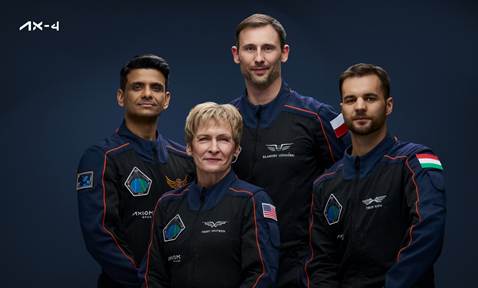India is poised to make history as Group Captain Shubhanshu Shukla of the Indian Air Force prepares to become the first Indian astronaut in over four decades to travel to space. Selected under the Indian Space Research Organisation’s (ISRO) Human Spaceflight Programme, Shukla will serve as Mission Pilot for Axiom Mission 4 (Ax-4) to the International Space Station (ISS), launching aboard a SpaceX Falcon 9 on June 11, 2025. This mission, reviving the legacy of Rakesh Sharma’s 1984 spaceflight, underscores India’s bold ambition to lead in global space exploration.
Managed by Axiom Space and led by Commander Peggy Whitson of the USA, Ax-4 is a landmark collaboration involving India, Poland, and Hungary, each sending government-sponsored astronauts to the ISS for the first time. Shukla’s role highlights India’s growing prominence in the global space community, focusing on operational readiness, microgravity adaptation, and advanced scientific experiments in space biology and life support systems. His work will include pioneering studies on edible microalgae to explore their growth under microgravity and space radiation, alongside research on cyanobacteria like Spirulina and Synechococcus for self-sustaining life support systems. An ISRO-led project, Voyager Tardigrades, will investigate the resilience of tardigrades in space, aiming to uncover molecular mechanisms for surviving extreme environments. Additional experiments on crop seeds, myogenesis, STEM demonstrations, and sprouts will further bolster India’s space science expertise. These efforts, developed in partnership with ISRO, NASA, and the Department of Biotechnology, are vital for long-duration missions and align with India’s Gaganyaan Programme, targeting a crewed mission to Low Earth Orbit by 2027.
The Gaganyaan Programme, backed by a ₹20,193 crore budget, is India’s flagship initiative for indigenous human spaceflight. It aims to develop and validate technologies for safe crewed missions, with a vision to establish the Bharatiya Antariksh Station by 2035 and achieve a crewed lunar landing by 2040. Four Indian Air Force test pilots—Group Captains PB Nair, Ajit Krishnan, Angad Pratap, and Shukla—have completed rigorous training. As of May 2025, the programme is in its final phase, with the Human-rated LVM3 vehicle, Crew Escape System, and Crew Module undergoing final testing for a planned 2027 launch. Gaganyaan is expected to drive technological innovation, industrial growth, and high-tech job creation, while inspiring future generations in STEM fields.
India’s space programme has already achieved remarkable milestones. Between January 2015 and December 2024, ISRO launched 393 foreign satellites and three Indian customer satellites, serving 34 countries, including the USA, UK, and Singapore. In 2017, ISRO set a world record by launching 104 satellites in a single mission. The Chandrayaan-3 mission made India the first nation to land on the Moon’s southern pole, with the Pragyan rover confirming sulphur presence. The Aditya L-1 solar mission, launched in 2017, captured unprecedented solar flare data in February 2025. Upcoming initiatives like the SpaDeX mission in December 2024 will demonstrate indigenous docking technology, while ISRO’s Orbital Re-entry Vehicle will enable autonomous re-entry and landing capabilities.
International collaborations are central to India’s space strategy. Partnerships with NASA on the NISAR mission, ESA on astronaut training and microgravity research, CNES on the TRISHNA satellite, and JAXA on lunar exploration studies highlight India’s global role. The India Space Policy 2023 and liberalized FDI norms, allowing up to 100% investment in certain space activities, have fueled private sector growth, with over 328 space startups emerging in recent years. Central Public Sector Enterprises like Antrix Corporation Limited and NewSpace India Limited, alongside IN-SPACe, are driving innovation and commercialization. The space budget has nearly tripled over the past decade, from ₹5,615 crore in 2013-14 to ₹13,416 crore in 2025-26, reflecting strong government commitment.
India’s Space Vision 2047 outlines ambitious goals, including the Bharatiya Antariksh Station, lunar landings, and missions to Venus.














